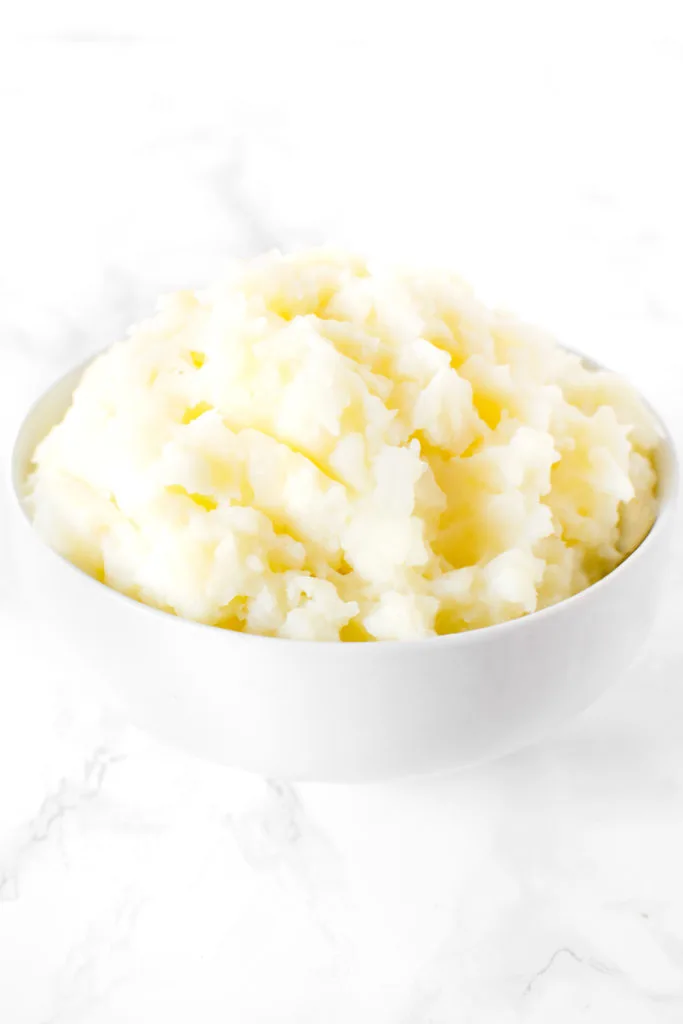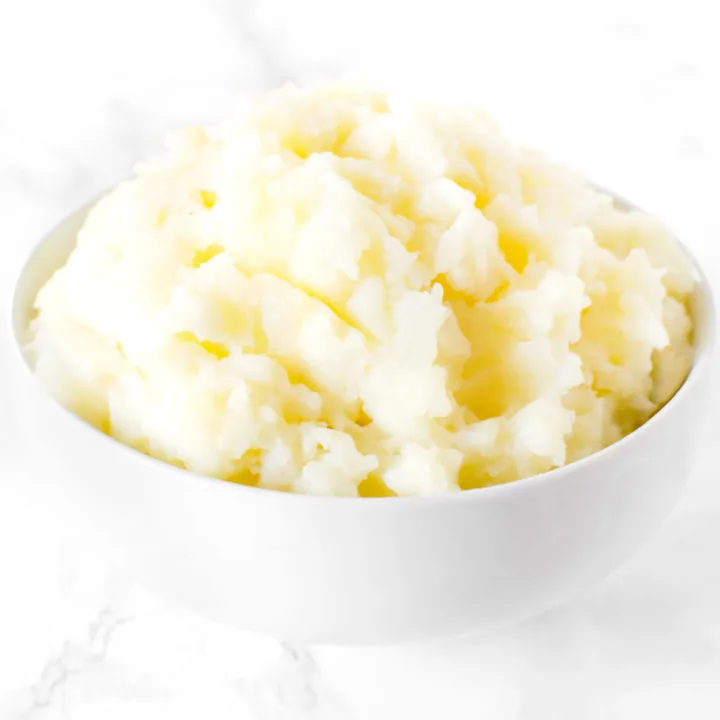These oat milk mashed potatoes are dairy free and are oh so delicious!
They really make the perfect side for anything from a weekly family dinner to a holiday dinner.

I have made so many different types of dairy free mashed potatoes that it was a challenge figuring out how to make these oat milk mashed potatoes special.
My mashed potatoes without butter and mashed potatoes with almond milk both have garlic but one calls for olive oil and the other for mayonnaise (mayonnaise is a secret ingredient for some of my favorite recipes).
Then there are my mashed potatoes without milk, which uses stock instead for a rich flavor.
Mashed potatoes with coconut milk and mashed potatoes with mayonnaise are full of flavor, but the names speak for themselves.
Dairy free mashed sweet potatoes, like dairy free potato casserole, may be mashed potatoes, but they are also their own thing entirely.
So, to make these mashed potatoes special, I decided to make dairy free buttermilk mashed potatoes with oat milk.
However, if you don't want the tang of the buttermilk, you can skip the step to make the buttermilk from oat milk and just use regular oat milk. Either way will be delicious.
History of Mashed Potatoes
While rice was imported into Europe since ancient times (brought from Asia by returning soldiers from Alexander the Great's military and later imported from Egypt), potatoes, while commonly associated with Ireland, were brought to Europe by the Spanish the second half of the 1500's.
Potatoes became an international staple because they were cheap to grow and high in nutrition.
They are a rich source of vitamin B6 and vitamin C, providing almost 25% of your daily value of each.
Potatoes are very versatile, and mashed potatoes are arguably the most common way they are prepared and eaten.
The first recipe for mashed potatoes first appeared in The Art of Cookery by Hannah Glasse in 1747.
Boil your Potatoes, peel them, and put them into a Sauce-pan, mash them well: To two Pounds of Potatoes put a Pint of Milk, a little Salt, stir them well together, take care they don’t stick to the Bottom, then take a quarter of a Pound of Butter, stir in and serve it up.
While the Art of Cookery originated in England, it was very popular in the Thirteen Colonies as well in America after the War of Independence.
In fact, Benjamin Franklin, Thomas Jefferson, and George Washington all owned copies of it.
About Dairy Free Mashed Potatoes
While mashed potatoes don't have to contain dairy, they almost always do.
Most mashed potato recipes include milk, buttermilk, cream, butter, sour cream, and/or cheese.
You can make mashed potatoes without milk by replacing it with another liquid such as almond milk, oat milk, coconut milk, reserved starchy water, regular water, chicken stock, or vegetable stock.
It doesn't really make a difference if you use milk, water, or any other liquid, because one isn't necessarily better than the other.
To replace buttermilk in mashed potatoes, substitute it with dairy free buttermilk by using buttermilk made with oat milk or buttermilk made with almond milk.
To make mashed potatoes without butter, you need to substitute the fat in butter with another form of fat like oil.
Mayonnaise is also a surprisingly good substitute for butter and sour cream in mashed potatoes.
Can I use oat milk instead of milk in mashed potatoes?
Yes, you can substitute milk for oat milk in mashed potatoes like this recipe does.
How to make creamy mashed potatoes without milk?
Additions like dairy free milk, coconut cream, almond cooking milk, water, and mayonnaise can all help make something creamy without dairy.
What you use really depends on what you are making. With dairy free mashed potatoes, any of these options work.
Milk actually doesn't make mashed potatoes super creamy. It mostly just adds liquid so the potatoes aren't dry.
It is the addition of fat that makes mashed potatoes and other dishes creamy.
This fat usually appears in the form of butter, or sometimes creamy cheese or even sour cream.
However, you can use other forms of fat such as oil to get that creaminess.
To make them extra creamy, add a little bit of mayonnaise like I do in this recipe. You won't taste the mayonnaise, but the mashed potatoes will be oh so creamy!
WHAT IS BUTTERMILK?
Buttermilk was originally the liquid left behind after churning butter out of cultured cream.
Traditionally, the milk was left to sit to allow the cream and milk to separate. During this time, naturally occurring lactic acid bacteria fermented the milk and turned it into buttermilk, making it tangier and thicker than regular milk.
However, modern buttermilk is made by adding lactic acid bacteria to milk to ferment it.
What Kind of Oat Milk should I use to make buttermilk?
Some oat milks can be too thin to get a good buttermilk out of them. For this reason, use a full fat oat milk like Oatly and Alpro.
Choosing your Brand
I have tried a handful of oat milk brands and I can tell you, not all oat milks are created equal.
Some brands taste like oats and have the consistency of water. Other brands have a milder taste and are slightly reminiscent of milk. Oatly and Alpro are my two go-to brands.
When I visit New York, I really like Oatly, which I find to taste like regular milk and to be a little extra creamy. I'd assume this is true in Canada too.
In Israel, I only use the barista version of Oatly, which is still more watery than the regular Oatly in the States. I expect it is the same in Europe because that is where it is imported from.
For Israel and Europe, I find the Alpro oat milk indistinguishable from the Oatly Barista. However, the Alpro "Not Milk" oat milk I find to be almost identical to milk but a little sweeter - which I like.
DO YOU PEAL POTATOES BEFORE BOILING FOR MASHED POTATOES?
You can, but you don’t have to. Potatoes that have clean skin can be washed and left on.
I like leaving the skins on, but I choose which way to do it based on the preferences of whoever else will be eating it.
TYPES OF POTATOES
There are generally three types of potatoes: waxy, starchy, and those in between.
WAXY
Waxy potatoes, such as Red Bliss and fingerlings, have a smooth skin and creamy, almost shiny flesh.
Because waxy potatoes are relatively low in starch and high in moisture, they stay intact when they’re cooked.
STARCHY AKA FLOURY
The most common example of starchy potato are russets, A.K.A. Idaho potatoes.
As you may have guessed by their name, they’re higher in starch and lower in moisture than waxy potatoes. They have matte-skin and fall apart when boiled.
Starchy potatoes are ideal for adding creaminess to puréed soups or providing the airy, whipped texture to a mash. They are also good for roasting and frying.
IN-BETWEEN
These fall somewhere between the waxy and floury, making them the “all-purpose” potatoes. The most commonly known of them are Yukon Golds.
Because they hold their shape when boiled, grated, or fried, and yield to mashing, they’re very versatile.
BEST FOR MASHED POTATOES
Since the waxy are most flavorful but the starchy are airiest, for the ideal mashed potatoes use half and half. This is a tip I picked up from the New York Times.
However, if you could only choose one, choose the in between option like Yukon Gold.
Or, if where you live you don’t have any clear way to know what type of potato you have available, use whatever you have.
WATER TEMPERATURE
Believe it or not, it’s best to begin cooking potatoes in cold water. It doesn’t have to be chilled, just the cold side from the tap.
While this may sound counter intuitive, cold water helps the potatoes cook more evenly.
Also, if it’s better that way, why waste the gas and cooking time by boiling the water?
How To Store
Place in an airtight container or leave in a bowl and wrap in plastic wrap and refrigerate.
Oat Milk Mashed Potatoes

These oat milk mashed potatoes are completely dairy free. For something a little different, I turn the oat milk into buttermilk, but you can skip this step and just use plain oat milk if you prefer. Either way, these mashed potatoes will be delicious!
Ingredients
- 2 pounds potatoes, peeled and cut into 1-inch cubes
- 8 garlic cloves, peeled
- 3 cups water
- ½ cup full fat oat milk
- ½ tablespoon lemon juice or white vinegar, optional
- ¼ cup thinly sliced green onions, optional
- 1 teaspoon salt
- ⅛ teaspoon pepper
Instructions
- In a large saucepan, add potatoes, garlic, and water. Bring to a boil. Reduce heat. cover and simmer until potatoes are tender. Drain.
- In a small saucepan, add oat milk and lemon juice or vinegar. Let sit until slightly curdled - about 10 minutes. Or, skip this step if you'd like a non-buttermilk version.
- Heat buttermilk mixture (or regular oat milk if prefered) until warm. Pour over the potatoes and mash.
- Stir in green onions if desired. Stir in salt and pepper.
Nutrition Information:
Yield:
6Serving Size:
1Amount Per Serving: Calories: 158Total Fat: 0gSaturated Fat: 0gTrans Fat: 0gUnsaturated Fat: 0gCholesterol: 0mgSodium: 375mgCarbohydrates: 36gFiber: 4gSugar: 4gProtein: 4g
Kathy
Sunday 24th of December 2023
You never say what to do with 6 garlic cloves. Is this a typo?
ElissaBeth
Sunday 24th of December 2023
Oops thanks for pointing that out. They're boiled and mashed with the potatoes.